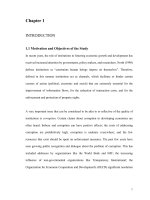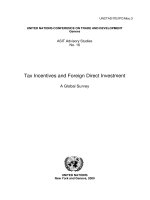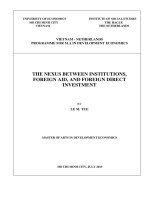Globalizing innovation state institutions and foreign direct investment in emerging economies
Bạn đang xem bản rút gọn của tài liệu. Xem và tải ngay bản đầy đủ của tài liệu tại đây (1.29 MB, 313 trang )
Globalizing Innovation
Globalizing Innovation
State Institutions and Foreign Direct Investment in
Emerging Economies
Patrick J. W. Egan
The MIT Press
Cambridge, Massachusetts
London, England
© 2017 Massachusetts Institute of Technology
All rights reserved. No part of this book may be reproduced in any form by any electronic
or mechanical means (including photocopying, recording, or information storage and
retrieval) without permission in writing from the publisher.
This book was set in Palatino LT Std by Toppan Best-set Premedia Limited. Printed and
bound in the United States of America.
Library of Congress Cataloging-in-Publication Data
Names: Egan, Patrick, 1978- author.
Title: Globalizing innovation : state institutions and foreign direct investment
in emerging economies / Patrick J. W. Egan.
Description: Cambridge, MA : MIT Press, [2017] | Includes bibliographical
references and index.
Identifiers: LCCN 2017019415 | ISBN 9780262037358 (hardcover : alk. paper)
Subjects: LCSH: International business enterprises--Developing countries. |
Public institutions.
Classification: LCC HD62.4 .E374 2017 | DDC 338.8/881724--dc23 LC record available
at />
10 9 8 7 6 5 4 3 2 1
For Diane and Chip
Contents
List of Figures ix
List of Tables xi
Preface xiii
List of Abbreviations
xix
1Introduction 1
2
Multinational Enterprise, Innovation, and Development:
Theoretical Perspectives 21
3
Patterns of Innovation among Multinational Firms 59
4
The Determinants of Multinational Innovation in Emerging
Economies 103
5
Innovation-Intensive FDI and Host Country Institutions 151
6
Chasing the Tiger: Is Ireland’s Experience with FDI a Model
for Developing Countries? 189
7Conclusion 227
Appendixes 245
References 263
Index 283
List of Figures
Figure 2.1 State FDI strategies and possible outcomes 53
Figure 3.1 Sectoral evolution of FDI across sectors and countries, percentage
of total FDI stock, 1980–2010 70
Figure 3.2 Evolution of FDI across countries, manufacturing subsectors as
percentage of total manufacturing investment, 1980–2010 74
Figure 3.3 Evolution of FDI across countries, service subsectors as a
percentage of total service investment, 1980–2010 76
Figure 3.4 US direct investment abroad, majority-owned nonbank foreign
affiliates, R&D expenditures, 1999–2008 80
Figure 3.5 US direct investment abroad, majority-owned nonbank foreign
affiliates, R&D expenditures, developing regions, 1999–2008 81
Figure 3.6 Relative R&D expenditures by US firms, state comparison 82
Figure 3.7 US foreign affiliates research and development expenditures, as a
percentage of all US multinational R&D expenditures, 1999–2008 84
Figure 3.8 US foreign affiliates R&D expenditures, by region and sector as a
percentage of sectoral value added, 1999–2008 86
Figure 3.9 Patenting activity by registration country, sending country, and
broad sectoral category 88
Figure 3.10 Median R&D expenditure by decile of domestic material inputs,
2002–2005 firm surveys 97
Figure 3.11 Relationship between export intensity and R&D intensity, select
countries, 2002–2005 firm surveys 99
Figure 3.12 Mean levels of exports and local sourcing by region and presence
of local innovation, 2002–2005 firm surveys 100
Figure 5.1 Consistent and predictable governance and R&D intensity 183
Figure 6.1 Incidence of innovation among foreign-owned firms, 2008
CIS 206
Figure 6.2 Incidence of innovation among foreign-owned firms in
manufacturing subsectors, 2008 CIS 207
Figure 6.3 Incidence of innovation linkages among information and
communication firms, 2007 BERD 211
x
List of Figures
Figure 6.4 Incidence of innovation linkages among manufacturing firms, 2007
BERD 212
Figure 6.5 Incidence of innovation linkages among professional, scientific,
and technical activities firms, 2007 BERD 213
Figure 6.6 Incidence of innovation linkages among wholesale trade firms,
2007 BERD 214
List of Tables
Table 3.1 Innovation indicators in selected countries, 2010 67
Table 3.2 R&D expenditures of majority-owned foreign affiliates of US
multinationals, 2007 85
Table 3.3 Sectoral breakdown of R&D incidence and exporting, domestic
sourcing 96
Table 4.1 Determinants of US firm R&D spending as a percentage of value
added, 1999–2008, cross-sectional time-series analyses 118
Table 4.2 Innovation, sectoral profiles, and sectoral exports, cross-sectional
time-series analyses 128
Table 4.3 Determinants of US-origin patent counts, cross-sectional time-series
analyses 134
Table 4.4 Determinants of R&D incidence, 2002–2005 firm surveys 140
Table 4.5 Determinants of alternate innovation indicators, 2002–2005 firm
surveys 146
Table 5.1 R&D indexes for Investment Climate Surveys, by region 163
Table 5.2 Determinants of R&D incidence, 2002–2005 firm surveys 172
Table 5.3 Alternate determinants of R&D incidence, 2002–2005 firm
surveys 176
Table 5.4 Determinants of R&D spending intensity in innovative firms,
2002–2005 firm surveys 182
Table 6.1 Patent activity by sector and nationality, 2006 CIS 208
Table 6.2 Incidence of public sources of funding for innovative firms, 2007
BERD 220
Table 6.3 Sources of funding for in-house R&D, by sector and nationality, 2007
BERD 221
Table 6.4 Determinants of joint R&D projects with Irish universities and other
firms, 2007 BERD 222
Preface
The ideas and questions in this book have been percolating in my mind
a long time. In retrospect, I probably became interested in international
and comparative political economy as an exchange student in Brazil
over two decades ago, though I didn’t know those scholarly fields
existed at the time. When I arrived in August 1994, Brazil had just
introduced a new currency and stabilized inflation rates. I heard stories
of people rushing to spend their paychecks on the day they arrived, so
that they would not lose value. I also remember the inequality: rows
and rows of shanties stacked up in the hills behind newly constructed
shopping malls. In the mid-1990s in Brazil, measures of inequality
were among the highest in the world. As a student from a small town
in South Carolina, I experienced these things as a set of shocks to the
system. I met so many wonderful people in Brazil, and returned again
and again, always as a student and always fascinated by the country’s
development path. As time passed, I began to focus more and more
on the economic connections between my own country and Brazil. I
understood that the trade and investment flows between the economic
and political behemoths of North and South America were substantial
and growing. However, I did not yet understand their causes and
effects.
I received much-needed guidance and direction at the University of
North Carolina, Chapel Hill. As a graduate student in the department
of political science, I was drawn to classes in international political
economy (IPE) and comparative politics. IPE, in particular, offered
elegant explanatory frameworks for cross-national phenomena, and
foreign direct investment (FDI) was an issue area experiencing increased
scholarly attention. My own interests and work seemed to straddle the
subfields of international and comparative politics. On the one hand,
I was interested in a country (Brazil) and region (Latin America) with
xivPreface
an incredibly rich theoretic tradition in political economy. On the other
hand, the transnational phenomenon that had grabbed my attention
(FDI) seemed to belong under the purview of international relations.
I have since come to regard the separation between international and
comparative political economy as somewhat arbitrary, and have felt no
reservations in forcing the two together. After all, common IPE theories
that prioritize domestic societal interests or institutions as explanatory
factors are forced to open the black box of within-state politics.
I wrote a dissertation on FDI in Brazil, and in particular how Brazilian institutions had shaped incoming investment and promoted development through integration with the world economy. On completing
this dissertation, I was immediately confronted with two unpleasant
thoughts. First, that despite my best efforts, I would never know as
much about Brazilian politics as a native-born Brazilian academic.
Second, I would not be satisfied with turning the dissertation into a
book based on one country’s (or even one region’s) experience with
foreign investment. The book project had to be broader. So I set about
extracting what I could from the dissertation, expanding its questions
and lessons to a larger set of countries. The result of that effort is this
book.
I have long felt that the IPE literature on FDI could be greatly
expanded with a focus on the types of activities pursued by multinational enterprises. This has often been the domain of international
business studies, but there are numerous avenues for political economy
arguments concerning the evolving relationships between foreign
firms and host country governments. In my view, institutionalist perspectives are especially appealing for interpreting these relationships.
Governments are the gatekeepers for FDI. They may perform this job
poorly, but for good or ill they help condition what kinds of firms enter
and what kinds of activities those firms pursue. This book summarizes
my ideas on how states and firms pursue their sometimes overlapping interests, and most importantly how the form and function of
state institutions matter for firm activities. The argument of the book
requires the recognition that firms do not operate in a vacuum; they
are engaged in a continual dialogue with host country governments.
Societal explanations do not play as large a role in this account, as multinational firms often operate at a greater level of remove from societies
in host countries, particularly when compared with domestic firms. In
a broader sense, this book reaffirms (at least to my mind) a comparative
Prefacexv
institutionalist approach, as applied in a large-sample empirical setting
to the study of FDI.
I have benefited tremendously from the guidance and assistance
of many individuals and institutions while working on this project.
Tulane University provided me with pretenure leave in fall 2014. I
also received seed grant funding from the Murphy Institute for Political Economy at Tulane to conduct research in Ireland in summer 2012.
This led to a partnership with the Central Statistics Office in Dublin and
Cork, which kindly appointed me as an officer of statistics and allowed
me access to data on multinational activities in Ireland. I returned in
summer 2013 with the assistance of another research grant, and much
of what appears in chapter 6 is a result of these periods of fieldwork.
I am grateful to the staff at Dublin City University for providing me
with office space during these visits. I am also grateful to Tulane for
substantial research startup funds when I was hired as an assistant
professor. Many of these funds were used to procure the datasets that
are used in this book. I also want to acknowledge the support of the
School of Liberal Arts at Tulane and the department of political science.
It is rare to find institutions as dedicated to helping their employees
succeed, and it is appreciated.
I have also benefited from the comments of various audiences,
including attendees at a number of annual meetings such as the
American Political Science Association, International Studies Association, and the Southern Political Science Association. There were also
a number of smaller workshops in which individual chapters were
featured, including those of the young(ish) faculty workshop at Tulane.
A number of individuals have taken the time to provide extensive and
always appreciated comments on earlier drafts. I am indebted to Frank
Barry, Joel Blit, Juan Bogliaccini, Sam Brazys, Lawrence Broz, Geoffrey
Burn, Martin Dimitrov, Michael Fitzgibbon, Niamh Hardiman, Mirya
Holman, Diana Kapiszewski, Virginia Oliveros, Darius Ornston, Ben
Ross Schneider, Aaron Schneider, Eduardo Silva, Dan Tirone, Michael
Tyburski, and Mark Vail, among others. Geoff Dancy saved me a great
deal of time by helping me with count modeling. Michael Breen provided me with excellent comments, and both he and Iain McMenamin
were most accommodating at DCU. I am grateful to Adam Beauchamp
and Eric Wedig at the Tulane library. Kevin Phelan at the Central
Statistics Office in Cork was very helpful, as was Carol Anne Hennessy in Dublin. I have also received able research assistance from a
xviPreface
number of graduate students, including Lucia Kovacikova, Zhen Lin,
and Kayemba Mvula.
No matter how much time elapses since the end of graduate school,
I will forever be grateful to my graduate advisors. Jonathan Hartlyn,
John French (Duke), Gary Gereffi (Duke), Layna Mosley, and Evelyne
Huber were all on my committee, and my scholarship is better for
it. Layna in particular spurred much of my interest in FDI, and has
always been willing to help. Gary turned my attention to the value
chain literature, and for that I am grateful. Evelyne Huber, as my chair,
has earned my enduring admiration and respect (along with hundreds
of other graduate students and colleagues) for her work ethic, intellect,
and dedication to her students. Without Evelyne and John Stephens,
I would not be in this business. Even though we now work in different subfields, I am so grateful to both of them for being tough, supportive, and intellectually stimulating examples for future academics
to follow.
Emily Taber of MIT Press was enthusiastic about this project as soon
as I sent it to her, and I appreciate her confidence and patience as I completed this book. She has been very easy to work with for this first-time
book author, and has promptly answered all my questions about the
process. Portions of chapter 5 appeared in modified form as an article
in Business and Politics in 2013, and I thank the editorial office there and
Cambridge University Press for permission to use this material. Portions of the appendix on Generalized Methods of Moments models also
appeared in appendix form in a 2010 article I wrote for Latin American
Politics and Society. My thanks to Al Montero and Wiley. I also appreciate the detailed reviews provided by four anonymous reviewers for
MIT Press, as they have greatly improved the quality of the manuscript.
I am grateful to Peter Evans, Alexander Gerschenkron, John Dunning,
and Ted Moran (among many others) for their ideas. Although I have
likely forgotten to mention other individuals who have helped me, I
hope they know that I am grateful.
Of course I cannot forget to mention here my family and friends, as
they are the ones who have sacrificed the most to see me through. My
three boys, Jack, Liam, and Craig, are all excellent creative disruptors
and destructors, and they have made sure I do not take myself too
seriously. They are huge sources of joy in my life, joy I would not have
imagined possible before they arrived. My wife Gillian read through
every bit of this manuscript and corrected mistakes. More importantly,
she never doubted I would finish, supported our family unit in all the
Prefacexvii
ways possible, and makes my life easier (and classier) every day. My
friends here in New Orleans and all over the country have provided
much-needed distractions and enrich my life. The city of New Orleans
itself has been an outstanding place for research, teaching, and living
life. I thought when we first moved here that I had stumbled into
another dimension, a place with such weirdness and wonder that it
didn’t seem real. I still feel that way, and I am so glad we are here. Last,
I wish to thank my parents for their never-ending love and support. I
am dedicating this book to them, Diane and Chip. Mom first because
she is the one who made me sit down and do my homework.
New Orleans, Louisiana
February 2017 (Lundi Gras)
List of Abbreviations
BEA
Bureau of Economic Analysis
BERD
Business Enterprise Expenditure on R&D
BERI
Business Environment Risk Intelligence
BIT
bilateral investment treaty
CIS
Community Innovation Survey
CPI
Corruption Perception Index
EPZ
export processing zone
FDI
foreign direct investment
GDP
gross domestic product
GERD
gross domestic expenditure on research and
development
GMM
generalized method of moments
GVC
global value chain
ICRG
International Country Risk Guide
ICSID
International Centre for Settlement of Investment
Disputes
IMF
International Monetary Fund
IPA
investment promotion agency
IPE
international political economy
IPR
intellectual property rights
ISI
import substitution industrialization
IT
information technology
LPI
Logistics Performance Index
M&A
mergers and acquisitions
xx
List of Abbreviations
NBER
National Bureau of Economic Research
OECD
Organisation for Economic Cooperation and
Development
OLI
ownership, location, and internalization
OLS
ordinary least squares
PRS
Political Risk Services
PTA
preferential trade agreement
R&D
research and development
TRIMs
Trade-Related Investment Measures
TRIPs
Trade-Related Aspects of Intellectual Property Rights
TTU
technology transfer unit
UNCTAD United Nations Conference on Trade and Development
USPTO
US Patent and Trademark Office
WDI
World Development Indicators
WGI
World Governance Indicators
WIPO
World Intellectual Property Organization
WPM
world product mandate
WTO
World Trade Organization
1
Introduction
Rush-hour traffic in Nairobi can reach epic proportions. Kenya’s capital
is poorly served by its highway system, and robust economic growth
along with a burgeoning population have put pressure on infrastructure. Commutes from the suburbs can take up to two hours, depending
on traffic. Interspersed among the cars and trucks inching their way
through town are thousands of matatus, or public minibuses seating
approximately 20 people. Up to a third of Nairobi’s residents use these
buses for transportation every day (Kalan 2013). And where long commutes generate boredom, they also generate opportunity. In 2012, a
Kenyan startup named Flashcast designed a location-aware advertising system to be installed in these buses. 3G modems were connected
to GPS units, and from there to the red LED lights inside the buses.
These lights would then display ads, but also encourage the passengers
to participate in games, quizzes, and other diversions on their phones.
Beyond game-playing and advertising, however, the GPS units also
allow customers to track the progress of buses and make transportation
plans accordingly. As free wifi has increased among the matatu fleet,
Flashcast has increased in popularity. Yet soon after its inception, Flashcast had a problem. Its directors realized that they had accumulated
a great deal of data on commuters, including their behaviors and patterns. Given the company’s limited resources, Flashcast had no way to
analyze these data to create further commercially viable ventures. For
assistance, they turned to one of the largest, most established information technology (IT) multinationals: IBM.
In November 2013 IBM announced, to much fanfare (including
features in the Wall Street Journal and The Economist), that it was inaugurating its twelfth research lab in Nairobi.1 IBM Research Africa was
1. Vogt 2013; Grand Challenges 2013.
2
Chapter 1
the first lab on the African continent, located on the grounds of the
Catholic University of Eastern Africa in Karen, a wealthy suburb.
Other labs around the world include IBM’s Watson lab, right next to
MIT and Harvard, Almaden lab in California, and another lab near
ETH Zurich. Kenya’s President Uhuru Kenyatta attended the inauguration festivities, and the Kenyan government agreed to contribute at
least $10 million over the first five years of its operation. IBM chose
Kenya because of its emerging reputation as a tech center, particularly
in the use of mobile phone payment systems and rapid installation of
high-speed internet. The government has also nurtured a reputation
for efficient regulation of its information and communication technologies sector, and has grand designs to build an IT center south
of Nairobi, the so-called silicon savannah, by 2030. The IBM research
lab in Kenya therefore represents a bet on the future of the African
market, but also a shot across the bow of other companies such as
Google and Microsoft, which are also developing their African presence. IBM has since expanded its African research capabilities, opening
another facility at the University of Witwatersrand in Johannesburg in
April 2015.
IBM’s research lab investment was symbolic for a country and continent that had struggled to attract significant amounts of foreign direct
investment (FDI) for decades, let alone investment with a significant
research and development (R&D) component. Certainly, the lab has
been active, employing scientists from the African diaspora and partnering with numerous indigenous companies similar to Flashcast. By
lagging behind in the construction of communications infrastructure,
Africa has somewhat paradoxically created opportunity for a mobilebased economy, with cashless payment systems and the exponential
growth of smart phone utilization as prime indicators. There are certainly many reasons for optimism, and IBM’s decision gives another
boost to Kenya’s status as an investment destination for multinational IT companies. However, there are also reasons to remain cautious. Kenya, and Africa at large, presents many barriers to foreign
investors, and these barriers often diminish the efficient operation of
multinationals and their potential contributions to growth. The security situation in Kenya is uncertain, and corruption is still common.
Moreover, there are some limitations on the innovative work being
done by IBM and similar companies. Many of the projects being done
in Africa are research endeavors designed to find solutions for local
problems such as health and sanitation. This kind of applied work
Introduction3
being done at IBM Research Africa is often quite different from the
work done at the Almaden lab, where pure, or “blue sky,” research is
more common.2 That there is great need for these kinds of initiatives is
in no doubt. However, these activities can occasionally give the appearance of another form of foreign aid and/or corporate public relations
(PR), rather than commercially viable innovations for domestic and
foreign markets. Do IBM’s actions in Africa represent the beginning
of a trend? Will we see significant amounts of high-tech investment in
Africa’s future? Or is IBM the exception to the dominant patterns of
investment? What can Kenya’s government do to entrench this kind of
investment and provoke future investments like it?
Flashcast found a partner in IBM, and IBM has committed to
Kenya. This example illustrates a process of multinational-linked
innovation growing more common in emerging economies, and is the
subject matter of this book. I consider here the innovative activities of
multinational enterprises in developing countries. Two decades ago,
it would have been a much shorter book. While developing countries welcomed significant inward FDI flows in the 1980s and 1990s,
not much of that investment was innovation-intensive. This continued postwar trends, in which foreign investors looked to developing
countries as sources of raw materials, markets, and/or production
efficiencies, but rarely as locations for R&D facilities or other kinds
of innovative activity. Yet as foreign investment increased in poorer
countries, innovative activities of multinational firms have spread to
these locations as well. This contradicts longstanding notions of where
multinational firms locate innovation within their production chains.
Some of the best-known works in international business literature
characterize innovation as a highly centralized phenomenon (Vernon
1966; 1971; Hymer 1970; 1972). According to these and other works,
multinationals have strong incentives to keep their innovative activities close to home, in their countries of origin. Firms enjoy tangible and
intangible assets from new technologies and production processes, and
2. As an example of this, much has been made of IBM bringing the Watson project’s
African equivalent, nicknamed “Lucy” in reference to the fossil human ancestor, to the
research lab in Nairobi. However, the focus of this cognitive computing initiative in
Africa is on education and developing solutions to African problems (Bright 2016), not
necessarily on commercially viable applications for exterior markets. In an interview
with Fortune magazine, IBM Global Business Services chief Bridget van Kralingen
explained that Lucy was a “first instance” of Watson, and that its focus would be on
helping find solutions to energy, water, transportation, agriculture, and health care issues
in Africa (Lashinsky 2014).
4
Chapter 1
worry about losing their competitive advantages if innovations are
spread to affiliates abroad. Developing countries, with their often
relatively immature intellectual property protections, lack of other
regulatory infrastructure, and poor state capacity, were seen to be especially risky locations for innovative activities. Yet the recent spread
of innovation within multinational production chains is unmistakable. According to a 2005 report by the United Nations Conference
on Trade and Development (UNCTAD), approximately two-thirds of
global R&D spending is accounted for by business enterprises. The
lion’s share of this spending is done in developed countries. However,
the developing world is increasing its share of global business R&D
spending. Developing countries accounted for $20 billion in business
R&D spending in 1996, or 5.4 percent of global business R&D spending (UNCTAD 2005, 106). By 2002 that figure had reached $32 billion,
or 7.1 percent. By 2010, companies in the Fortune 500 list had 98 R&D
facilities in China and 63 in India (“The World Turned Upside Down”
2010). Blue-chip companies such as Ford, IBM, Pfizer, Microsoft, Intel,
Cisco, and Boeing have constructed R&D labs in not only China and
India, but also Brazil and South Africa (Hall 2010). This diffusion of
innovation within and among multinationals has occurred at the same
time as firms invest in more diverse sectors in emerging economies.
Gone are the days when natural resource-seeking multinationals dominated investment in poorer countries. In certain countries, one is now
just as likely to find an international accounting firm offering business
process outsourcing as a mining conglomerate.
As multinational investment in developing countries becomes more
diverse, and as multinationals adopt a variety of governance structures that may include polycentric innovation strategies, students of
foreign investment are presented with a puzzle. If firms are supposed
to conduct innovation close to home, what explains these new patterns? This book proposes a variety of answers to this puzzle, but its
most fundamental message is one rooted in the tradition of political
economy. Rather than concentrating on macroeconomic or firm-level
explanations for innovation outcomes, I argue that host country institutions and policies are vital to explaining the diffusion of innovation in
developing economies. Firms are attracted to the well-educated labor
forces that many developing countries have to offer. They are also
often eager to innovate close to new markets. But in addition to this,
the strength of host country institutions and the qualities of the country’s investment policies have a strong impact on firm decisions, both









